The war in Ukraine continues. Almost nine months of fighting have resulted in untold death and destruction. After suffering several setbacks on the battlefield in September, Russia recently returned its focus to bombing civilian infrastructure far from the front lines, leaving hundreds of thousands of Ukrainians without power, heat, or water as winter approaches. Little hope for negotiation exists under the current circumstances, promising to extend the loss of lives and livelihoods across the country well into the new year.
Since Russian troops first invaded Ukraine in February 2002, GeoPoll has been collecting data to monitor the situation on the ground using our Mobile Web survey platform. We published a series of reports in March and June 2022 detailing up-to-the-minute results from the surveys. Our interactive dashboard tracker (scroll to the bottom of this page) continues to display the full results, including responses to most survey questions filterable by region, age group, and gender, as well as trends over time.
In this post, we highlight key changes in the data over the past few months and detail the results from several new survey questions that have been added since the last report.
Perceptions of Foreign Influence
Russia’s invasion of Ukraine is having global consequences. The far-reaching impact is forcing nations from around the world to weigh in on the crisis. While the United States, the European Union (EU), and their allies implement sanctions on Russia and provide military and humanitarian assistance to Ukraine, other countries, including Iran and North Korea, have been supplying advanced weaponry to Russia.
Opinions of Foreign Entities
With much of the world involved in Ukraine in one form or another, we asked respondents for their opinions on several foreign powers. As the chart below displays, respondents in Ukraine clearly feel more favorably towards western powers that are supporting their efforts than they do towards China or especially Russia.
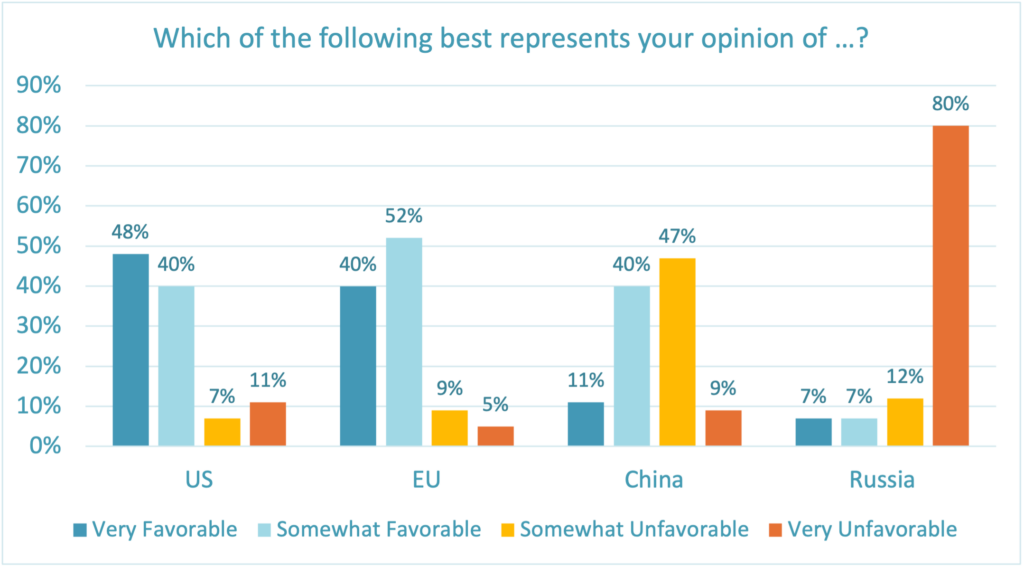
Perceived Value of Relationships with Foreign Entities
Respondents also express much more enthusiasm about building a closer relationship with the EU than with Russia. In response to Russia’s invasion, Ukraine recently became a candidate country to join the EU.
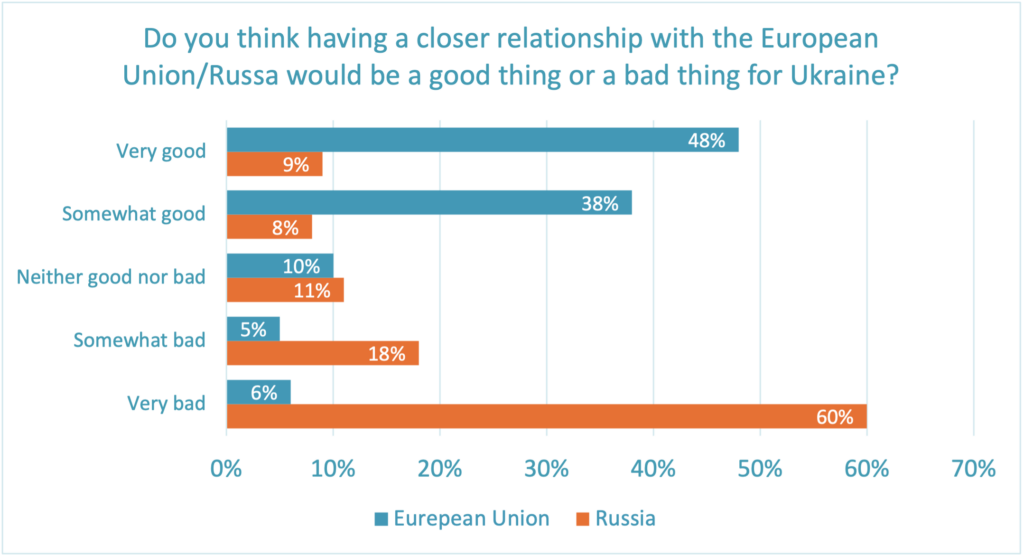
Many North Atlantic Treaty Organization (NATO) countries have provided arms and other military assistance to Ukraine since the war began but have drawn the line at offering troops. Following Russia’s annexation of four partially occupied regions in Ukraine on September 30, President Zelensky officially applied for “accelerated ascension” into NATO. Although unlikely in the near term, if Ukraine were to become a NATO member, other member countries would be obligated to join Ukraine’s defense.
In our study, aside from observed data irregularities in August (evident in the chart below and addressed at the end of this post) respondents have expressed overwhelmingly positive views about the prospect of Ukraine joining NATO. On average, 41% of respondents say it would be a “very good thing” for Ukraine to join NATO. Another 32% say it would be a “somewhat good thing.”
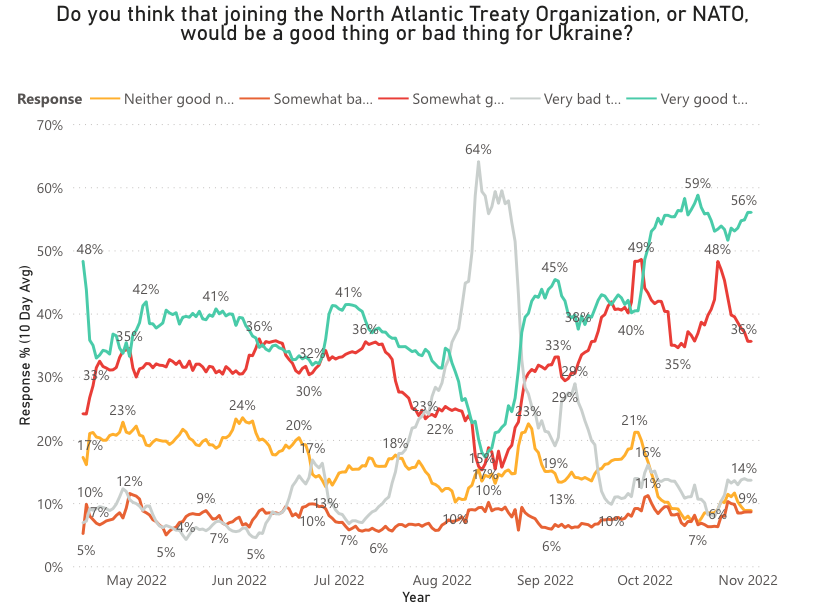
Russia’s announced annexation of Luhansk, Donetsk, Zaporizhzhia, and Kherson on September 30 and its renewed bombing campaign starting on October 10 appear to have strengthened those views. On September 29, 40% of respondents said it would be a “very good thing” for Ukraine to join NATO. By the end of October, that percentage climbed to 59%.
Safety and Displacement
Personal Safety
More than half the respondents in our ongoing study (52%) have reported feeling unsafe in their everyday lives. With rapid Ukrainian advances pushing back Russian troops in September, the running percentage steadily declined. That trend changed in mid-October, however, when a fresh wave of Russian drone and missile strikes pushed the number of respondents feeling unsafe to 68%. The airstrikes marked the biggest escalation in the conflict since fighting began.
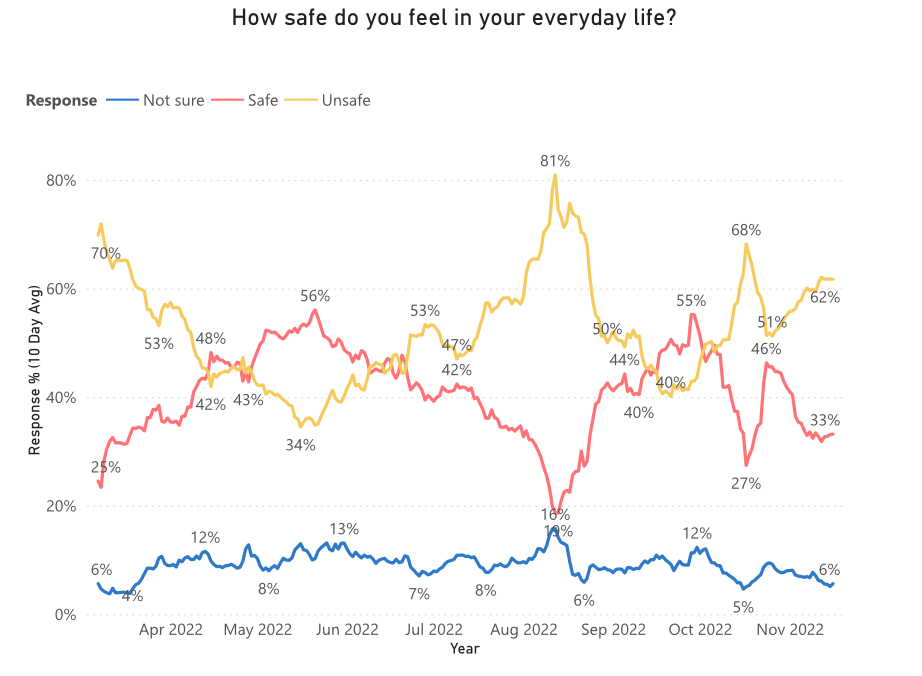
Personal and Observed Displacement
A similar trend surfaced for those saying they had to move or flee recently due to the war. After a gradual decline throughout September, the rate of displacement started to climb back up in mid-October along with the renewed bombing campaign, jumping from 27% to 40% by the end of the month. The UN estimates that more than 1 in 3 Ukrainians have been forced from their homes since the war began.
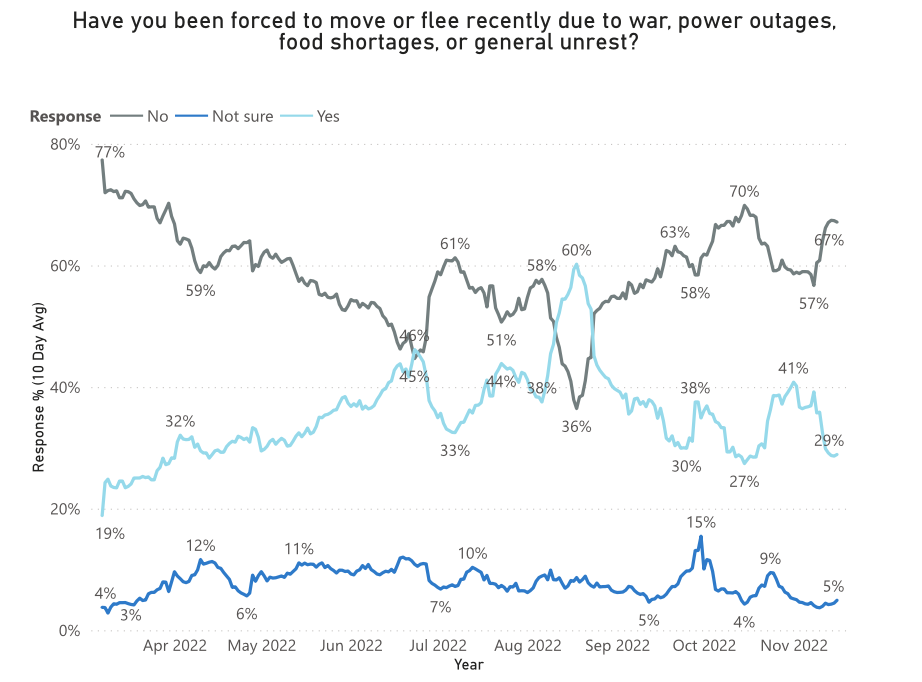
The percentage of respondents that claim to know someone that has been forced to move or flee has remained above 80% since last May. Where those people are moving, however, changed dramatically in October. On October 1, 30% of respondents said most of the people they know that have fled “have moved to another country.” That segment grew to 48% by October 31.
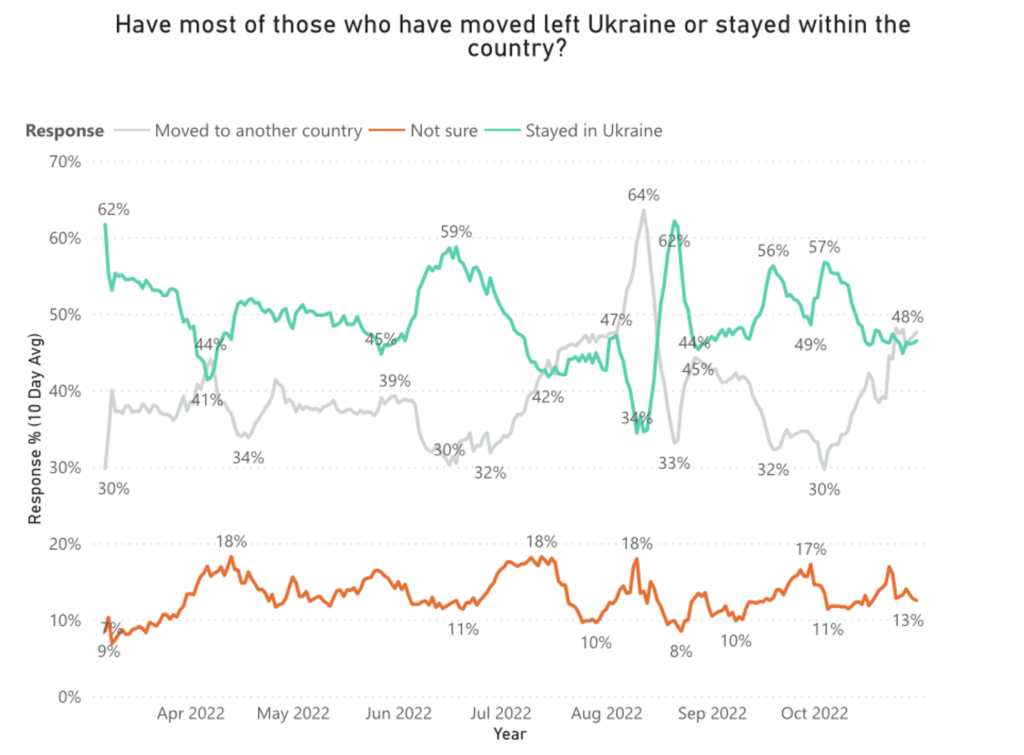
As of October 31, most respondents (82%) say they “plan to stay in the locality they are now” for the next few weeks. That percentage has climbed steadily since hovering around 67% in the month of May.
Access to Necessities
Coordinated missile attacks on Ukraine’s power grid are taking a toll. In addition to plunging much of the population into darkness, without electricity, authorities also struggle to provide citizens with water, fuel, or advanced medical care.
Food, Water, and Electricity Shortages
In our study, on October 10, 44% of respondents said they had experienced at least some shortages of necessities such as fuel, water, or electricity in the past few weeks. By mid-November, that percentage reached 80%.
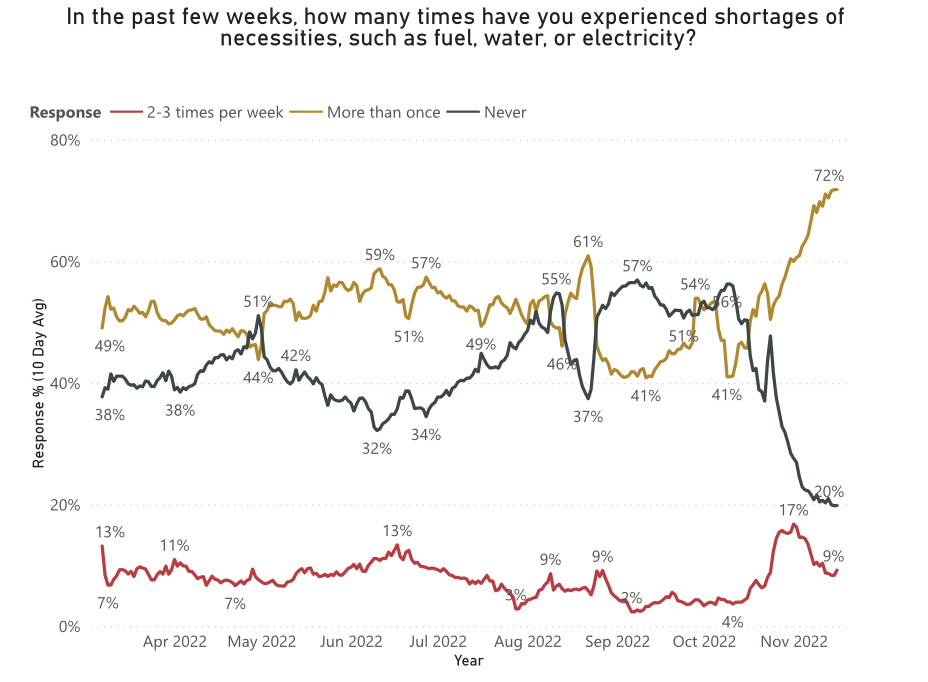
Communication Outages
Communication services appear to be faring even worse. A combination of missile attacks and cyber-attacks have damaged much of Ukraine’s electrical and communications infrastructure. Starlink satellite service has served as a communications lifeline for many civilians and the military throughout the war, but also recently experienced outages. In our study, the percentage of respondents that report experiencing communications outages at least 2-3 times per week exploded from 7% in mid-October to 34% in mid-November. Only 13% of respondents from across the country say they never experience outages.
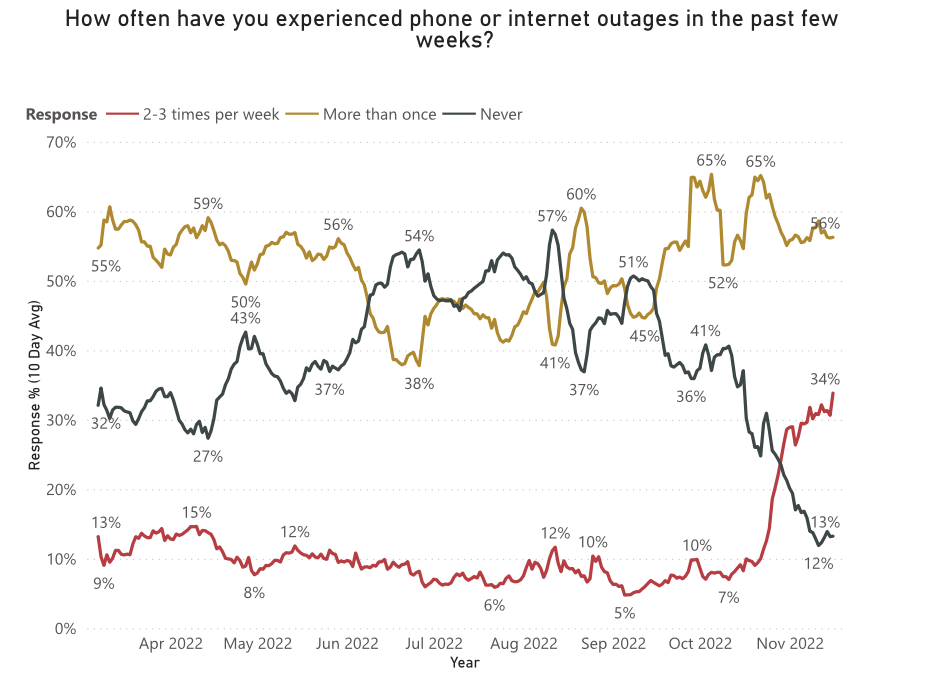
Primary News Platforms
Internet access is particularly important given the growing number of Ukrainians that rely on social media to follow the news. In our ongoing research study, the percentage of respondents using social media to follow the news has climbed steadily from 68% in early March to 87% on October 31. The percentage using TV has declined.
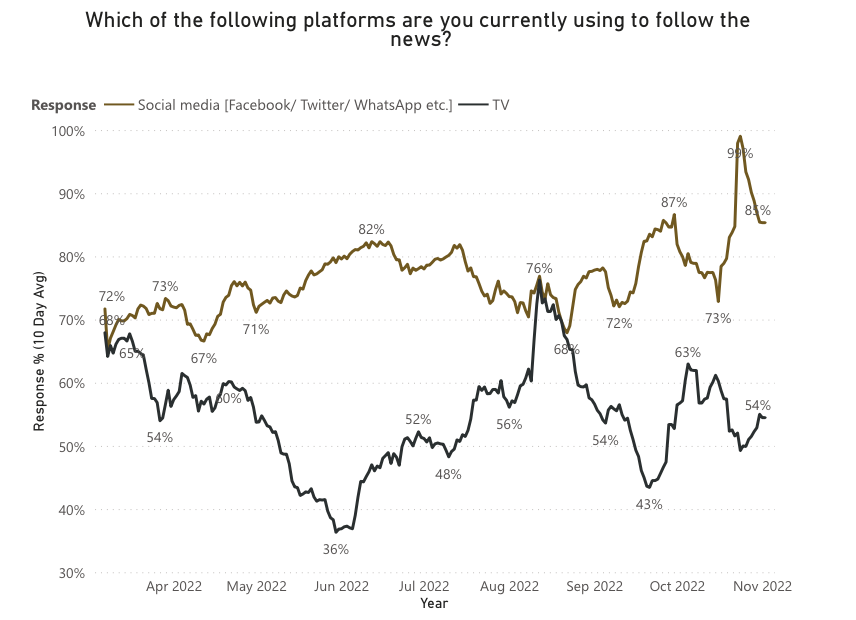
Building and Housing Status
Russia has bombarded towns and cities across all regions of Ukraine. Millions have been forced to flee some of the hardest hit locations already, but Russia’s recent escalation of missile attacks promises even more destruction and displacement in the days ahead.
Damage to Residential and Non-residential Buildings
Starting in October, we introduced questions in our survey asking respondents about the status of residential and non-residential buildings in their immediate area. As of November 15, 30% report at least moderate damage to the majority of residential buildings in their area, and 28% report at least moderate damage to the majority of non-residential buildings.
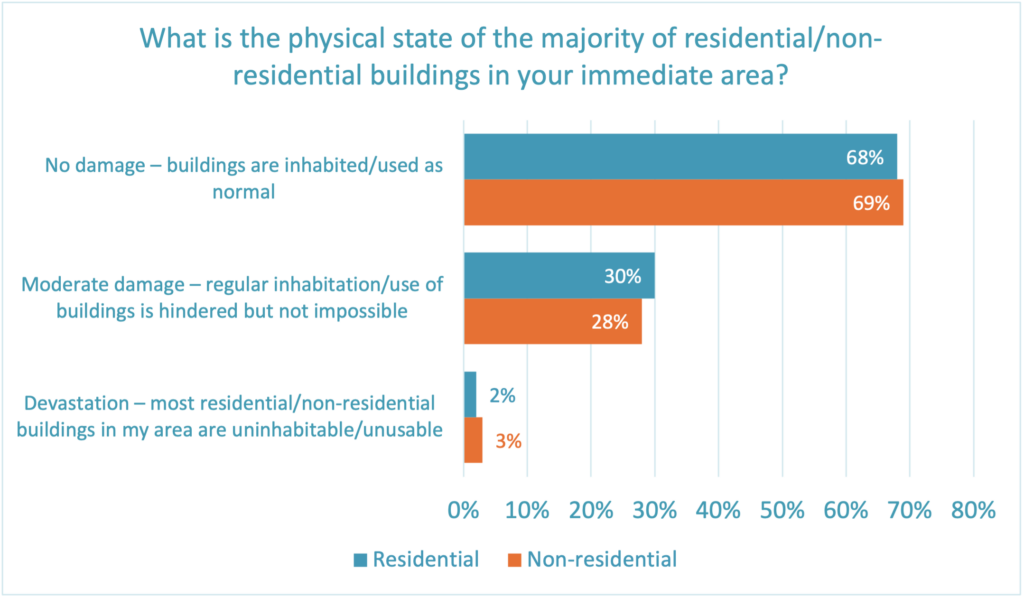
Current Living Situation
Respondents’ reported living situation follows their description of residential buildings in their area. Approximately 1 in 4 (24%) claim to currently be living somewhere other than their regular residence.
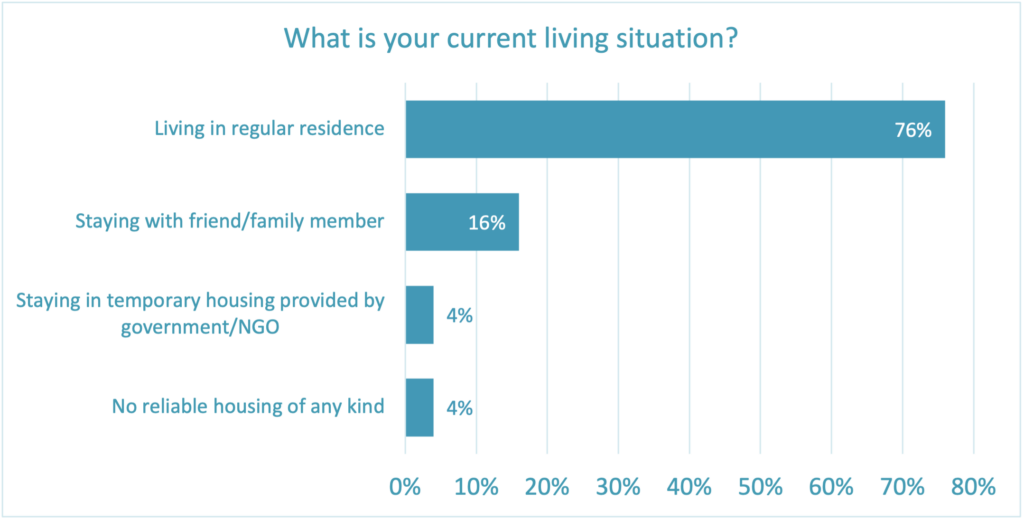
In July, the Ukrainian government estimated that more than 800,000 homes had been damaged or destroyed since Russia first invaded in February.
Impact on Daily Household Activities
Russia’s war has impacted almost every aspect of daily life in Ukraine. Aside from the dangers of the conflict and the damage to infrastructure, almost half the respondents in our study say the war has negatively impacted their ability to “socialize with friends and family” or to “go to work.” More than a third say it has impacted their ability to “run errands, such as grocery shopping, clothes shopping, or fueling vehicles.”
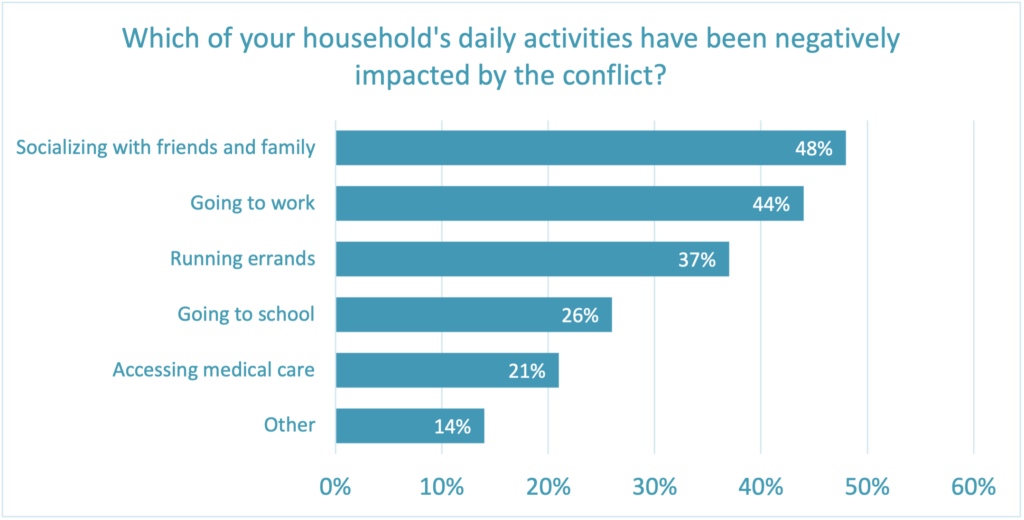
Humanitarian Relief
The Red Cross estimates that 18 million people in Ukraine are in need of humanitarian aid. Most respondents in our study (83% overall) say that humanitarian organizations are currently in their area to provide relief.
International Aid Received
The percentage that claims to have personally received aid in the form of food, money, water, or other supplies has more than doubled since March 2022, rising from 19% to 52% by mid-November.
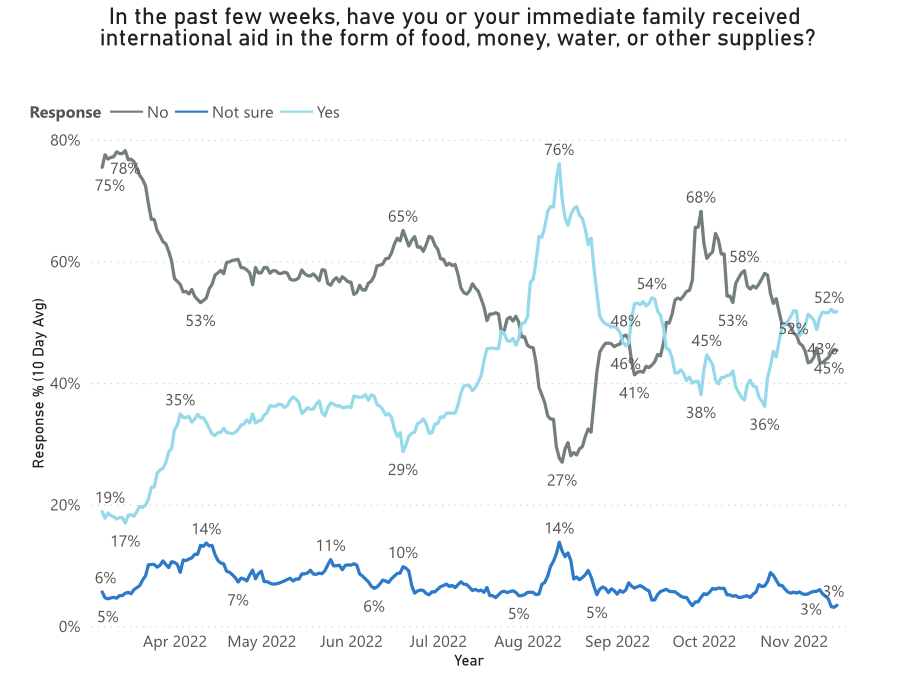
As the fighting intensifies and temperatures drop, more and more Ukrainians are likely to find themselves in desperate need of humanitarian assistance. Even if the war ended immediately, the heavy damage already inflicted on homes, essential infrastructure, and people’s lives and well-being in the region will require substantial international funding and relief for many years to come.
Reconstruction Priorities
After more than eight months of war, the destruction of civilian infrastructure in Ukraine is enormous. Ukrainian President Zelensky recently stated that approximately 40% of the country’s entire energy infrastructure has been seriously damaged. Since mid-October, Russia appears particularly focused on attacking Ukraine’s electricity infrastructure.
Damage to Energy Infrastructure
Russia’s assault on Ukraine’s electricity infrastructure is reflected in the steadily growing number of respondents in our study that claim to have experienced “electricity” shortages since mid-October (much more than any other fuel source).
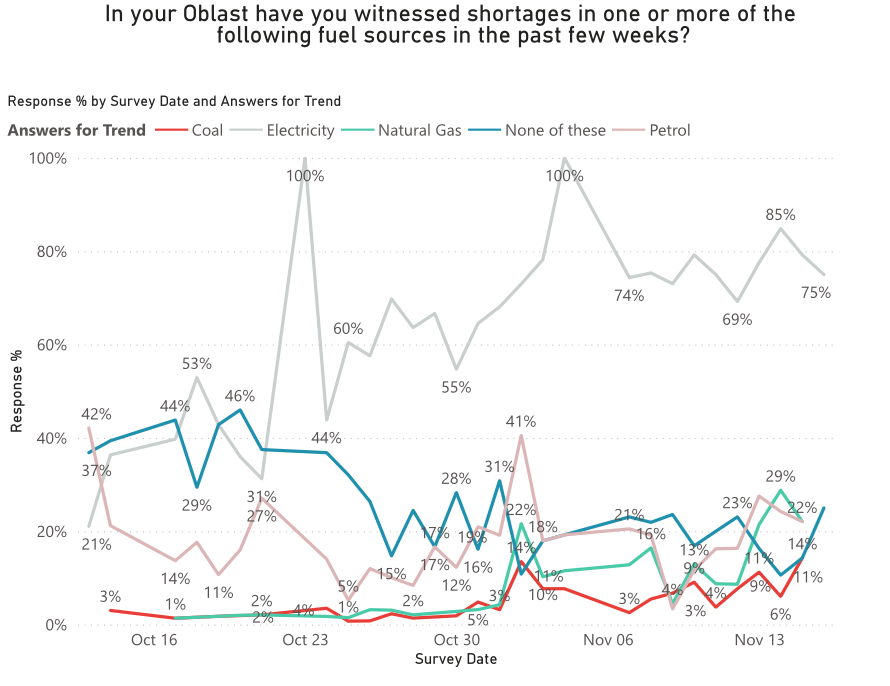
Physical Reconstruction Needs
Considering the current shortages, it follows that 3 out of 4 respondents in our study (74%) believe reconstructing their Oblast’s “power/electricity facilities” should be a top priority when hostilities cease. Rebuilding “roads” comes in a distant second at 31%. Rebuilding “homes” is rated the third highest priority at 21%.
Despite frequent reported outages, only 11% of respondents believe repairing their Oblast’s “telecommunications” infrastructure should be a top priority.
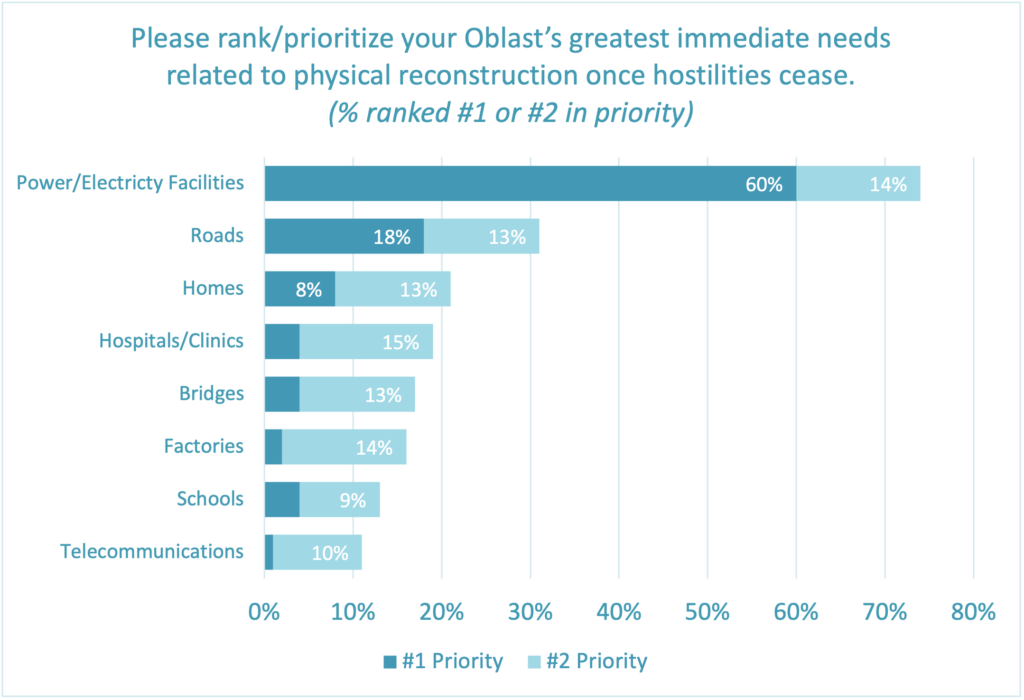
Data Irregularities in August
Looking back at trends in the survey data over the past eight months, curious spikes appear in the opposite direction of the trendlines in the middle of August. The number of survey completes also dropped during that timeframe. After averaging around 65 completes per day in the first 5 months of the study, the average fell to 18 completes per day between August 1 and August 21 – then immediately climbed back up to more than 60 completes per day starting August 22.
Digging deeper into the data, many of the spikes offer a pro-Russian sentiment. For example, respondents’ opinions of Russia and China are much more favorable in that timeframe, while their opinions of the US are much less favorable.
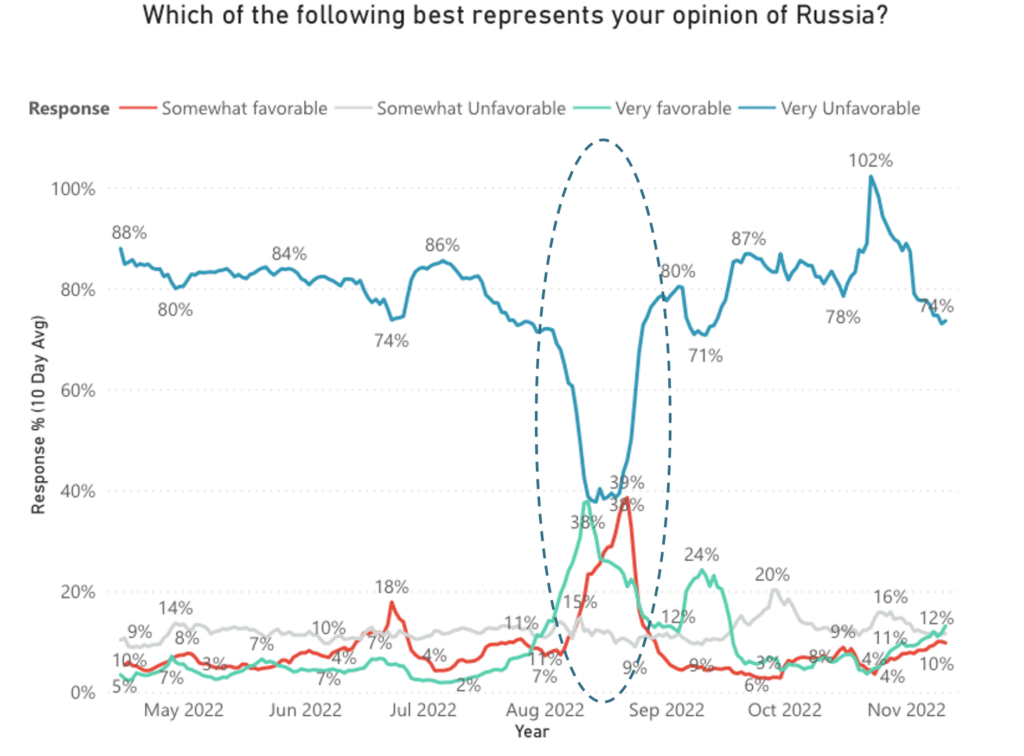
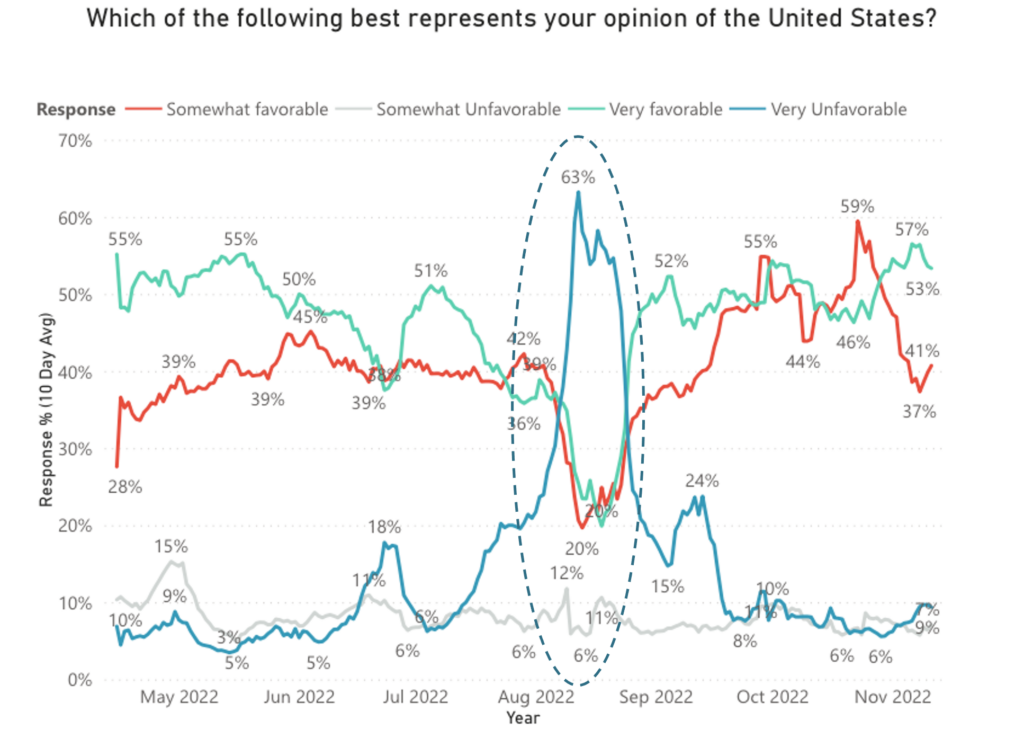
Other examples include:
- Those claiming to be ethnically Russian rose from 4% to 17% in August
- The percent claiming Russian as their primary language more than doubled (35% to 78%)
- Those saying joining NATO would be “a very bad thing” for Ukraine climbed from averaging less than 20% to 64%
- Those saying having a closer relationship with Russia would be “a very good thing” spiked from averaging less than 10% to 44%
To view the spikes in the trendlines for all survey questions, scroll down to our interactive dashboard tracker (scroll down).
Russia’s interference with Ukraine’s internet offers a potential reason for the spikes. As described in a New York Times article from August 9, Russia has been working to restrict, reroute, or shut down the internet and cellular networks in large sections of eastern and southern Ukraine. This control and censorship of Ukraine’s internet by Russia could help explain the increase in pro-Russian sentiment, as well as the decrease in survey completes in August. The article also describes how restoring connectivity has been one of Ukraine’s first objectives as they regain control of Russian-controlled regions, which could explain why Russian sentiment and the number of completes quickly returned to normal at the end of August.
Monitoring trends in data collection over time provides a unique opportunity to identify potential infiltration by parties that may wish to drive a particular narrative.
Interactive Data Dashboard
GeoPoll’s interactive data dashboard displays the full results from the ongoing survey in Ukraine, including responses to each question filterable by region, age group, and gender, as well as trends over time.
Click the arrows “< >” at the bottom of the dashboard to scroll through the following data tabs:
- All Data: Charts responses to each question in the survey filterable by region, age group, and gender
- Daily Data: Tracks daily responses to select questions in the survey
- Trends (10 Day Avg): Displays trends in responses to select survey questions using rolling 10-day averages
Conduct Research in Ukraine
GeoPoll has extensive experience conducting research in vulnerable areas using our remote mobile-based systems and methodologies. In times when it is otherwise impossible to get information from people on the ground, remote data collection can play a pivotal role in capturing the sentiment and realities in hard-to-reach populations.
To learn more about GeoPoll’s capabilities in Ukraine and around the world, please contact us.
